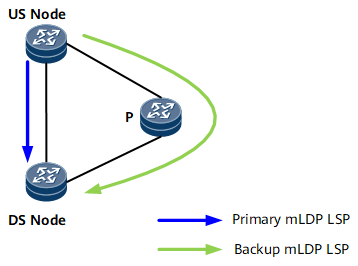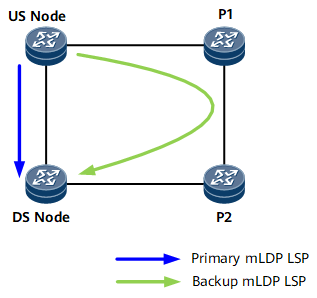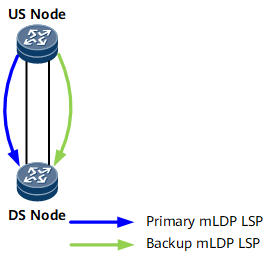mLDP FRR Link Protection
mLDP fast reroute (FRR) is a protection technique for mLDP LSPs. It consists of node protection and link protection. In this section, link protection is described.
Background
With the growth of user services, the demands for using mLDP LSPs to carry multicast traffic are increasing. Therefore, mLDP LSP protection techniques become increasingly important. In implementation of a mLDP LSP protection technique, an mLDP FRR LSP can be established if routes are reachable and the downstream outbound interface of an mLDP LSP is not co-routed with the outbound interface of the primary mLDP LSP. mLDP FRR link protection is implemented using the primary route to a downstream device, LFA FRR route, RLFA FRR route, or multi-link method, which improves user network reliability.

mLDP P2MP FRR link protection does not support backup links on a TE tunnel.
Related Concepts
- DS node: downstream node
- US node: Upstream node
Implementation
An upstream node generates an mLDP FRR path for each outbound interface of an mLDP LSP. If the outbound interface of the primary LSP fails, the forwarding plane rapidly switches traffic to the mLDP FRR path to a directly connected downstream LDP peer, which protects traffic on the primary LSP.
- An mLDP FRR path has P2P LDP labels and its destination is the downstream directly connected LDP peer.
- The outbound interface of a P2P LDP LSP is different from the outbound interface of the primary LDP LSP.

mLDP FRR link protection only protects traffic on the outbound interface of the primary mLDP LSP.
A link fault on the primary mLDP LSP triggers protocol convergence on the control plane. To minimize packet loss during the convergence, configure LDP GR Helper and mLDP MBB.
- After the upstream node detects the link fault, the forwarding plane rapidly switches traffic. A P2P LDP label is added to the outbound label of the original primary mLDP LSP in each packet. The packet is forwarded by the P to the downstream node. After the downstream node removes the P2P LDP label, the node swaps the mLDP LSP outgoing label with another label before sending the packet downstream.
- Without mLDP FRR link protection, the LDP GR helper function must be enabled for the path between the upstream and downstream nodes. The GR helper function protects the active and standby forwarding entries from being deleted on the upstream node in case of an LDP session disconnection. Consequently, the MBB process can continue on the destination node.
- Without mLDP FRR link protection, mLDP MBB must have been enabled on a device. Once the control plane detects a fault, the downstream node identifies the change in the next hop of a route to the root node and enters the MBB process. After the DS node-P-US node path is established, the downstream node receives traffic sent only by the new upstream P node to complete the convergence process.
Usage Scenarios
Figure 1 shows the typical triangle networking.
Figure 2 shows the typical four-point ring networking. If an RLFA route to the downstream node is used and the outbound interface of the RLFA FRR route differs from the outbound interface of the primary LSP, the upstream node selects the RLFA FRR path as a backup path.
- Figure 3 shows typical multi-link networking.
- If multiple links load-balance traffic, the upstream node selects a load-balancing link as a protection path, but does not select the outbound interface of the primary mLDP LSP.
- If multi-link routes form an LFA FRR path, the upstream node selects a protection path in the same way as that in the typical triangle networking.
- If one of multiple links has an active route and FRR is disabled, the upstream node selects one of multi-link interfaces as a protection path, but does not select the outbound interface of the primary mLDP LSP.
Benefits
mLDP LSP link protection offers the following benefits:
Reduces bandwidth consumption.
Reduces deployment costs.


